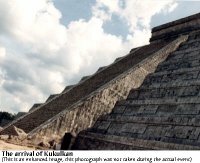The El Castillo(the castle) was dedicated to
Kukulkan. This building is built and aligned with the sun so precisely that it
serves as a giant sun dial which shows the Spring Equinox and the Autumn Solstice.
During the Spring Equinox the large layers of the pyramid form sunlit triangles on one
side of El Castillo starting at the top. As the day goes on more and more triangles start
to appear working their way down the pyramid. Finally the sunlight hits a large
snake head at the bottom of the pyramid forming a giant sunlit snake. During the Autumn
Solstice the shadowing starts at the head and works back up to the top of the pyramid.
This snake known to the Mayan people as Kukulkan, the Feathered Serpent worked it's way
down from the heavens to deliver prosperity to the Mayan people. In present day over
40,000 people make the trek to Chichén Itzá in order to witness this event.
 El Castillo is a time temple that sheds light on the Mayan astronomical system It was
built in 800 just before the Toltec invasion. An impressive 78 feet tall, the
temple's name means castle in Spanish. El Castillo is actually a huge solar
calendar. There are 91 steps on each of its four sides. If you multiply
91 times the 4 sides you would get 364, adding the crowning platform you get
365.
El Castillo is a time temple that sheds light on the Mayan astronomical system It was
built in 800 just before the Toltec invasion. An impressive 78 feet tall, the
temple's name means castle in Spanish. El Castillo is actually a huge solar
calendar. There are 91 steps on each of its four sides. If you multiply
91 times the 4 sides you would get 364, adding the crowning platform you get
365.
If you did the math, you would find that the
91 steps on each side, times 4 for each side and each season, plus 1 for the crowning
platform adds up to 365. The Mayan calendar incorporates the movements
of the sun and moon and is as accurate as the calendar that we use today. How
could they have possessed this knowledge at a time when western man thought the world was
flat?
The god Kukulkan descended to earth and
taught the Maya in science and mathematics. This is a common theme throughout
the ancient world.